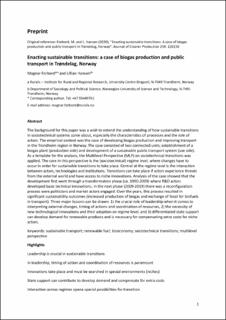| dc.contributor.author | Forbord, Magnar | |
| dc.contributor.author | Hansen, Lillian | |
| dc.date.accessioned | 2022-02-14T09:58:51Z | |
| dc.date.available | 2022-02-14T09:58:51Z | |
| dc.date.created | 2020-10-05T16:49:26Z | |
| dc.date.issued | 2020 | |
| dc.identifier.citation | Journal of Cleaner Production. 2020, 254 1-11. | en_US |
| dc.identifier.issn | 0959-6526 | |
| dc.identifier.uri | https://hdl.handle.net/11250/2978687 | |
| dc.description.abstract | The background for this paper was a wish to extend the understanding of how sustainable transitions in sociotechnical systems come about, especially the characteristics of processes and the role of actors. The empirical context was the case of developing biogas production and improving transport in the Trondheim region in Norway. The case consisted of two connected units; establishment of a biogas plant (production side) and development of a sustainable public transport system (use side). As a template for the analysis, the Multilevel Perspective (MLP) on sociotechnical transitions was applied. The core in this perspective is the (sociotechnical) regime level, where changes have to occur in order for sustainable transitions to take place. Central at the regime level is the interaction between actors, technologies and institutions. Transitions can take place if actors experience threats from the external world and have access to niche innovations. Analysis of the case showed that the development first went through a transformation phase (ca. 1990–2009) where R&D actors developed basic technical innovations. In the next phase (2009–2019) there was a reconfiguration process were politicians and market actors engaged. Over the years, this process resulted in significant sustainability outcomes (increased production of biogas and exchange of fossil for biofuels in transport). Three major lessons can be drawn: 1) the crucial role of leadership when it comes to interpreting external changes, timing of actions and coordination of resources, 2) the necessity of new technological innovations and their adoption on regime level, and 3) differentiated state support can develop demand for renewable products and is necessary for compensating extra costs for niche actors. | en_US |
| dc.language.iso | eng | en_US |
| dc.publisher | Elsevier | en_US |
| dc.rights | Attribution-NonCommercial-NoDerivatives 4.0 Internasjonal | * |
| dc.rights.uri | http://creativecommons.org/licenses/by-nc-nd/4.0/deed.no | * |
| dc.title | Enacting sustainable transitions: A case of biogas production and public transport in Trøndelag, Norway | en_US |
| dc.type | Peer reviewed | en_US |
| dc.type | Journal article | en_US |
| dc.description.version | acceptedVersion | en_US |
| dc.rights.holder | This is the authors' manuscript to an article published by Elsevier | en_US |
| dc.source.pagenumber | 1-11 | en_US |
| dc.source.volume | 254 | en_US |
| dc.source.journal | Journal of Cleaner Production | en_US |
| dc.identifier.doi | 10.1016/j.jclepro.2020.120156 | |
| dc.identifier.cristin | 1837288 | |
| cristin.ispublished | true | |
| cristin.fulltext | preprint | |
| cristin.fulltext | preprint | |
| cristin.qualitycode | 2 | |

